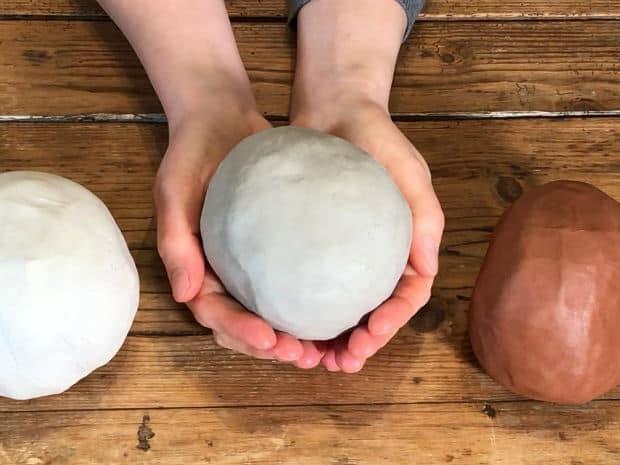main
How to Start a Pottery Hobby Easy and Fast
When it comes to hobbies, every individual has their inclinations and likings that they wish to explore. An element of uniqueness is associated with these hobbies. The pottery wheel is not the exception. With the advent of the digital age, information sharing has become incredibly easier to educate people who wish to hone this skill of pottery. Your pottery journey can also be filled with elegant and fascinating experiences if you follow the tips below.
Pottery hobby is counted as one of the most captivating and relaxing habits that help you experience communion with nature. Who doesn’t want that? A pure, pristine experience of curating aesthetical designs and shapes is undoubtedly a must-try endeavor.
But one particular question that vexes the beginners profusely is how to start this intriguing hobby. The overwhelming information online might derail you sometimes, and you might also end up receiving information that doesn’t necessarily serve the purpose.
So let us make life easier for you.
This article is determined to help you with the problem. Below are some highlighted and highly effective tips that will assist you in honing your skills. Furthermore, they will lead you to work productively and efficiently at any time of the day.
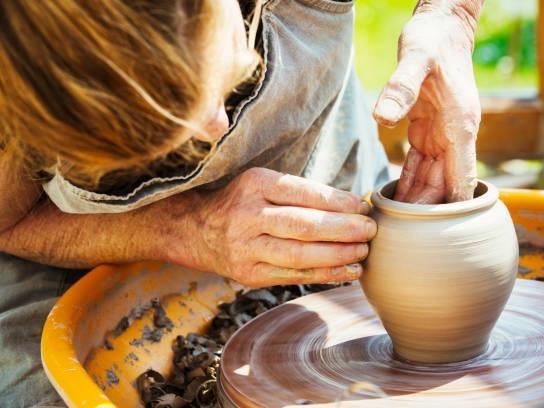
 Slip casting is a predominant method of mixing clay with water to dilute it into the liquid. Slip is essentially a type of clay that has different thicknesses. Some slips are dense and sticky; whereas, others might be smooth enough to be poured and are relatively thin. Slip casting enables you to carve out different shapes and versions from the same piece. You can use the slip-cast to make evenly proportioned handicrafts.
Slip casting is a predominant method of mixing clay with water to dilute it into the liquid. Slip is essentially a type of clay that has different thicknesses. Some slips are dense and sticky; whereas, others might be smooth enough to be poured and are relatively thin. Slip casting enables you to carve out different shapes and versions from the same piece. You can use the slip-cast to make evenly proportioned handicrafts.
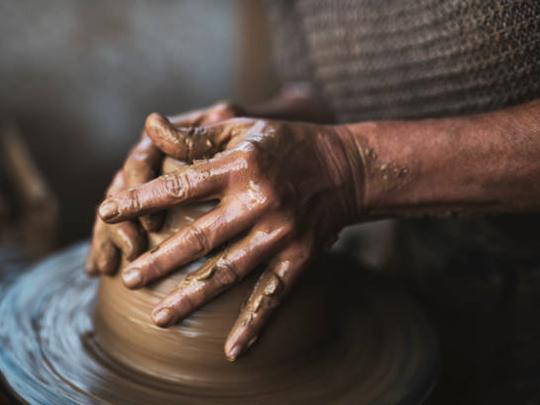 Manual hand-building pottery is another renowned method embraced by most individuals who seek to find their solace in pottery. You can kick off this technique by incorporating hand-building techniques that don’t necessarily require any equipment. All you need is some clay along with a few common tools to begin making pottery in no time.
As the name suggests, you do not require any pottery wheel to begin because your hands serve the purpose holistically. This method will give you a semblance of sculpting. If you have a background in sculpture, then this method will undoubtedly be your thing.
Four methods have been recognized in terms of hand-building pottery:
Manual hand-building pottery is another renowned method embraced by most individuals who seek to find their solace in pottery. You can kick off this technique by incorporating hand-building techniques that don’t necessarily require any equipment. All you need is some clay along with a few common tools to begin making pottery in no time.
As the name suggests, you do not require any pottery wheel to begin because your hands serve the purpose holistically. This method will give you a semblance of sculpting. If you have a background in sculpture, then this method will undoubtedly be your thing.
Four methods have been recognized in terms of hand-building pottery:
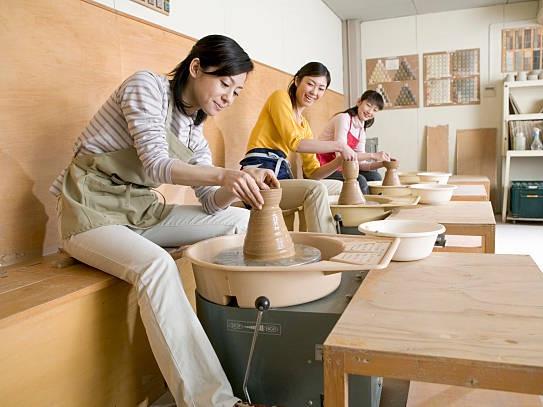 Wheel thrown pottery is a widely acclaimed method that utilizes a pottery wheel. This equipment helps you spin clay at will, providing a seamless flow for you to make your desired pottery with utter comfort.
Using the pottery wheel is undeniably a profuse amount of fun that you can leverage ANYTIME, and it provides a sense of communion with the environment. It is a little challenging to do at first until you become seasoned with time. But once you get it right, the pottery wheel will propel you to make fascinating pottery.
Wheel thrown pottery is a widely acclaimed method that utilizes a pottery wheel. This equipment helps you spin clay at will, providing a seamless flow for you to make your desired pottery with utter comfort.
Using the pottery wheel is undeniably a profuse amount of fun that you can leverage ANYTIME, and it provides a sense of communion with the environment. It is a little challenging to do at first until you become seasoned with time. But once you get it right, the pottery wheel will propel you to make fascinating pottery.
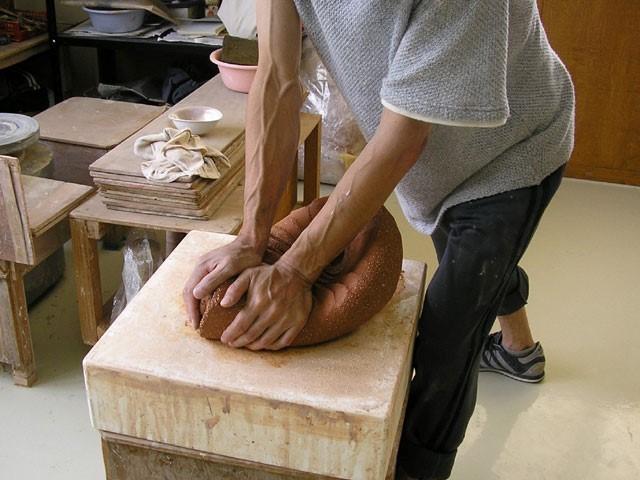 Being equipped with a fair amount of knowledge and essential tools, it’s time that you get to work for real. You have to start preparing your clay for pottery, but right after wedging. Now, this term “wedging” might have vexed you, but it’s a good thing you stumbled upon this article. So, to make your clay ready for use, you are supposed to follow an initial procedure to start working. These are:
Being equipped with a fair amount of knowledge and essential tools, it’s time that you get to work for real. You have to start preparing your clay for pottery, but right after wedging. Now, this term “wedging” might have vexed you, but it’s a good thing you stumbled upon this article. So, to make your clay ready for use, you are supposed to follow an initial procedure to start working. These are:

1. Be Specific About the Technique.
There are three predominant techniques that a beginner can adopt to excel at this hobby over time. However, Mastering the skill requires strong commitment and perseverance. The three integral methods of making pottery include:- Slip casting
- Manual hand-building pottery
- Wheel thrown pottery
Slip casting
 Slip casting is a predominant method of mixing clay with water to dilute it into the liquid. Slip is essentially a type of clay that has different thicknesses. Some slips are dense and sticky; whereas, others might be smooth enough to be poured and are relatively thin. Slip casting enables you to carve out different shapes and versions from the same piece. You can use the slip-cast to make evenly proportioned handicrafts.
Slip casting is a predominant method of mixing clay with water to dilute it into the liquid. Slip is essentially a type of clay that has different thicknesses. Some slips are dense and sticky; whereas, others might be smooth enough to be poured and are relatively thin. Slip casting enables you to carve out different shapes and versions from the same piece. You can use the slip-cast to make evenly proportioned handicrafts.
Manual hand-building pottery
 Manual hand-building pottery is another renowned method embraced by most individuals who seek to find their solace in pottery. You can kick off this technique by incorporating hand-building techniques that don’t necessarily require any equipment. All you need is some clay along with a few common tools to begin making pottery in no time.
As the name suggests, you do not require any pottery wheel to begin because your hands serve the purpose holistically. This method will give you a semblance of sculpting. If you have a background in sculpture, then this method will undoubtedly be your thing.
Four methods have been recognized in terms of hand-building pottery:
Manual hand-building pottery is another renowned method embraced by most individuals who seek to find their solace in pottery. You can kick off this technique by incorporating hand-building techniques that don’t necessarily require any equipment. All you need is some clay along with a few common tools to begin making pottery in no time.
As the name suggests, you do not require any pottery wheel to begin because your hands serve the purpose holistically. This method will give you a semblance of sculpting. If you have a background in sculpture, then this method will undoubtedly be your thing.
Four methods have been recognized in terms of hand-building pottery:
- Slab pottery
- Mold pottery
- Coil pots
- Pinch pots
Wheel thrown pottery
 Wheel thrown pottery is a widely acclaimed method that utilizes a pottery wheel. This equipment helps you spin clay at will, providing a seamless flow for you to make your desired pottery with utter comfort.
Using the pottery wheel is undeniably a profuse amount of fun that you can leverage ANYTIME, and it provides a sense of communion with the environment. It is a little challenging to do at first until you become seasoned with time. But once you get it right, the pottery wheel will propel you to make fascinating pottery.
Wheel thrown pottery is a widely acclaimed method that utilizes a pottery wheel. This equipment helps you spin clay at will, providing a seamless flow for you to make your desired pottery with utter comfort.
Using the pottery wheel is undeniably a profuse amount of fun that you can leverage ANYTIME, and it provides a sense of communion with the environment. It is a little challenging to do at first until you become seasoned with time. But once you get it right, the pottery wheel will propel you to make fascinating pottery.
2. Clay Selection Before Making Pottery
You have two prevalent options at your disposal to choose from when it comes to clay selection. These are:- Ceramic Clay/Pottery Clay
- Air Dry Clay
Ceramic clay
Ceramic clay is produced at a kiln, implying that the clay cannot be further dissolved in the water. Pottery clay can be further classified into three main categories: Earthenware, Porcelain, and Stoneware. Because you are a beginner, porcelain should be the least choice. Although it is undoubtedly a beautiful way to manifest the best of potteries, it requires deliberate knowledge and master skill. Furthermore, it is not one of the clays that you can seamlessly work with. Hence, you’d better begin with earthenware or stoneware pottery.Air-dry clay
Air-dry clay can be dried in the open air, a simpler process when compared to drying at a kiln. As far as the types are concerned, air-dry clay has several kinds, which can be a polymer and give a semblance of being plastic. These are highly compatible with making jewelry and toys. But, since you are planning on making pottery, choose a more pottery-oriented clay. Regular pottery clay is reinforced with fiber, making it possible to dry hard and not have to be put at a kiln. Air-dry clay is generally used on the pottery wheel.3. Why Do You Want to Work With Clay?
Working with clay is an unforgettable experience and helps you to take a glimpse into its tender side. It propels your skill level and enables you to develop patience. With the easy accessibility of pinch pots, you can commence your pottery habit anytime, depending on your convenience. It barely takes an hour to learn how to make a pinch pot. You certainly won’t experience any boredom, and with a proper slew of measures, you’re bound to succeed in making your first pottery. Moreover, your skill will gradually mature with continuous learning.4. What You Should Know Before Buying the Clay?
There are inevitably a large number of variables in clay and glazes. You must consider factors like “the specific temperature of clay that it matures at.” Glazes have to properly align with the clay, considering the temperature at which it starts maturing. “Cone” is a specific term that generally rates the clays and glazes. Heat work is measured this way. If you want to know more about “Cone”, check this out.5. Highly Convenient Pottery Tools
With your endeavor and strong determination, you will soon have your favorite and most cherished pottery tools. However, there are some specific pottery tools that you must develop a firm grasp on before advancing further. You can purchase a pottery starter kit that includes almost everything you will need initially. The underlying advantage of buying a starter kit is that you wouldn’t have to buy each tool separately and save a significant amount of money. This also ensures that you are equipped with all the proper tools you require while making your pottery.6. It’s Time You Prepare the Clay
 Being equipped with a fair amount of knowledge and essential tools, it’s time that you get to work for real. You have to start preparing your clay for pottery, but right after wedging. Now, this term “wedging” might have vexed you, but it’s a good thing you stumbled upon this article. So, to make your clay ready for use, you are supposed to follow an initial procedure to start working. These are:
Being equipped with a fair amount of knowledge and essential tools, it’s time that you get to work for real. You have to start preparing your clay for pottery, but right after wedging. Now, this term “wedging” might have vexed you, but it’s a good thing you stumbled upon this article. So, to make your clay ready for use, you are supposed to follow an initial procedure to start working. These are:
- Watch out for air bubbles in the clay and remove them
- Properly wake the clay
- Carefully align the clay particles


